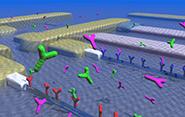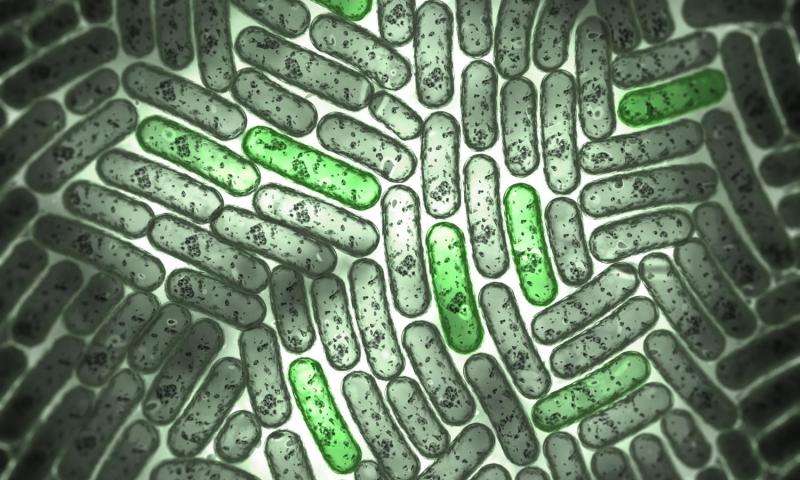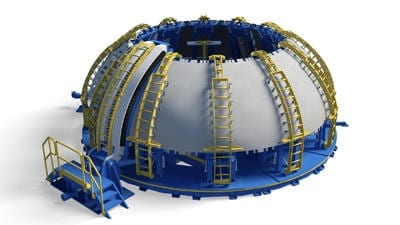Imagine a swarm of tiny devices only a few hundred nanometers in size that can detect trace amounts of toxins in a water supply or the very earliest signs of cancer in the blood.
Now imagine that these tiny sensors can reset themselves, allowing for repeated use over time inside a body of water – or a human body.
Improving nanodevice biosensors is the goal of Mark Reed, Harold Hodgkinson Professor of Electrical Engineering at the Yale School of Engineering & Applied Science. Reed and his colleagues have reported a recent breakthrough in designing electronic biosensors that can be regenerated and reused repeatedly.
Biosensors are used to detect and measure toxins in the environment; in the body they can identify chemical biomarkers that signal cancer and disease states by detecting changes at the molecular level. Reed’s lab has created biosensors using silicon nanowires configured as tiny transistors that are exponentially more sensitive than current sensing technology, in addition to being cheaper and easier to use.
Reed’s latest research, published in the journal ACS Nano, outlines a method to add a layer of molecules to the surface of the biosensor that can be chemically regenerated, allowing for reuse. The ability to recharge nanodevice biosensors makes them more useful for applications like the remote monitoring of toxins or biothreats.
The Latest Bing News on:
Electronic biosensors
- Conductive Ink Market Is Encouraged to Reach USD 5.6 Billion by 2033 at a CAGR of 6.3%on April 26, 2024 at 2:15 am
According to Market.us, the Conductive Ink Market size is projected to surpass around USD 5.6 billion by 2033, from USD 3.5 billion in 2023, and it is poised to reach a registered CAGR of 6.3% from ...
- EQS-News: XTPL records all-time high revenues, Strategy execution remains on trackon April 26, 2024 at 12:06 am
Issuer: XTPL S.A. / Key word (s): Annual Results XTPL records all-time high revenues, Strategy execution remains on track 26.04.2024 / 07:30 CET/CEST The issuer is solely responsible for the ...
- Quick Detection of Vitamins C and D in Saliva Using Bioelectronic Chipon April 25, 2024 at 9:00 am
According to a study that was published and featured on the journal cover of ACS Applied Nano Materials, scientists from the University of São Paulo (USP) in Brazil have created a bioelectronic chip ...
- Electrotherapy System Market size worth $ 1587.04 Billion, Globally, by 2031 at 4.39% CAGR – Report By Verified Market Research®on April 24, 2024 at 7:14 am
Explore the Lucrative Landscape of Electrotherapy Systems - Uncover Market Insights, Growth Trends, and Profitable Opportunities TodayJersey City, New Jersey, April 24, 2024 (GLOBE NEWSWIRE) -- The ...
- Carbon Nanotubes Market Size, Opportunities, Share, Growth, Regional Trends, Key Segments, Graph and Forecast to 2028on April 23, 2024 at 10:35 am
Carbon Nanotubes Market by Type (Single Walled & Multi Walled), End Use Industry (Electronics & Semiconductors, Chemical Materials & Polymers, Structural Composites, Energy & Storage, Medical), Method ...
- Scientists stencil-paint carbon nanotube components for flexible transparent electronicson April 23, 2024 at 9:23 am
Researchers from Skoltech, MIPT, and elsewhere have found a fast and inexpensive way to create geometric patterns in carbon nanotube films. The resulting films turned out to have superior properties ...
- Growing Demand from Electrical and Electronics Sectors Propels Conductive Polymer Coatings Market Amidst Cost Challengeson April 23, 2024 at 8:46 am
The conductive polymer coatings market is projected to grow at an impressive pace with a CAGR of 9.3% during 2022-2032. Widespread use of conductive polymer coatings for corrosion protection and ...
- Miniature sensors, offer rapid on-site measurement of traces of ‘forever chemicals’, at values below European Union thresholdon April 22, 2024 at 7:27 am
Grapheal, a deep-tech startup developing specialised biosensors, and the EDYTEM laboratory, a joint research unit between France’s Center for Scientific Research (CNRS) and Savoie Mont Blanc ...
- Biosensors Market Growth Foreseen To Achieve USD 63.07 Billion Value By 2032, With An Estimated 9% CAGRon April 19, 2024 at 7:15 am
According to Market.us, the global biosensors market is projected to expand significantly, reaching an estimated value of approximately USD 63 billion by 2032, up from USD 27.2 billion in 2022. This ...
- Wafer-thin, stretchy and strong as steel: could ‘miracle’ material graphene finally transform our world?on April 13, 2024 at 9:26 am
“You cannot make electronic devices with scraps like that ... “We also believe we could use our biosensors to detect whether or not someone has sepsis, in a few minutes,” said Humphreys. The fact that ...
The Latest Google Headlines on:
Electronic biosensors
[google_news title=”” keyword=”electronic biosensors” num_posts=”10″ blurb_length=”0″ show_thumb=”left”]
The Latest Bing News on:
Biosensors
- Three McCormick Faculty Elected to American Academy of Arts and Scienceson April 26, 2024 at 10:09 am
Wei Chen, Mark C. Hersam, and Uri J. Wilensky are among the 250 members elected in 2024, and six from the University. They are recognized for their excellence and commitment to uphold the Academy’s ...
- EQS-News: XTPL records all-time high revenues, Strategy execution remains on trackon April 26, 2024 at 12:06 am
Issuer: XTPL S.A. / Key word (s): Annual Results XTPL records all-time high revenues, Strategy execution remains on track 26.04.2024 / 07:30 CET/CEST The issuer is solely responsible for the ...
- Bob Marley Bikes, Mushroom Leather Sandals, Hybrid Inflatable Crazy Creeks, and More Emerging Gearon April 25, 2024 at 3:58 pm
It's a great week to explore outdoor gear! Check out new tents, trail food subscriptions, and multiuse camping accessories. The post Bob Marley Bikes, Mushroom Leather Sandals, Hybrid Inflatable Crazy ...
- The UW’s Institute for Protein Design keeps boosting startups, fueling AI-powered scienceon April 25, 2024 at 11:28 am
On Tuesday the latest venture based on IPD technology emerged: Xaira, a San-Francisco area startup co-founded by IPD head David Baker, backed with more than $1 billion from investors including Arch ...
- The Lundquist Institute Receives $2.6 Million Grant from U.S. Army Medical Research Acquisition ...on April 24, 2024 at 5:33 pm
The U.S. Army Medical Research Acquisition Activity (USAMRAA) has awarded The Lundquist Institute (TLI) a four-year grant totaling $2,623,234. The research project ...
- The Lundquist Institute Receives $2.6 Million Grant from U.S. Army Medical Research Acquisition Activity to Develop Wearable Biosensorson April 24, 2024 at 5:32 pm
The proposed sensor has the potential to not only revolutionize COPD management but also to impact healthcare by incorporating wearable electronics into chronic disease management Dr. Harry Rossiter, ...
- AI is boosting drug discovery and development — and sparking questions about proprietary dataon April 23, 2024 at 1:51 pm
AI and Biotech panel at Life Science Innovation Northwest 2024. From left: Danielle Greenawalt, Lynda Stuart, Sean McClain, Jonathan Cohen and moderator ...
- Scientists stencil-paint carbon nanotube components for flexible transparent electronicson April 23, 2024 at 9:23 am
Researchers from Skoltech, MIPT, and elsewhere have found a fast and inexpensive way to create geometric patterns in carbon nanotube films. The resulting films turned out to have superior properties ...
- Biosensors Market Growth Foreseen To Achieve USD 63.07 Billion Value By 2032, With An Estimated 9% CAGRon April 19, 2024 at 7:15 am
According to Market.us, the global biosensors market is projected to expand significantly, reaching an estimated value of approximately USD 63 billion by 2032, up from USD 27.2 billion in 2022. This ...
- RNA's hidden potential: New study unveils its role in early life and future bioengineeringon April 18, 2024 at 1:21 pm
The beginning of life on Earth and its evolution over billions of years continue to intrigue researchers worldwide. The central dogma or the directional flow of genetic information from a deoxyribose ...
The Latest Google Headlines on:
Biosensors
[google_news title=”” keyword=”biosensors” num_posts=”10″ blurb_length=”0″ show_thumb=”left”]
>











